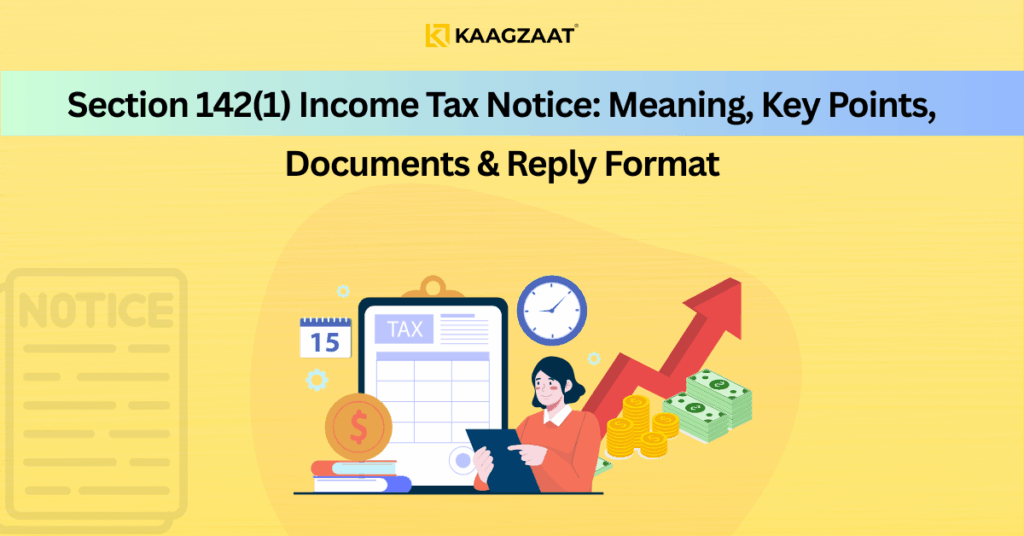Section 142(1) Income Tax Notice: Meaning, Key Points, Documents & Reply Format

Getting a notice under Section 142(1) of the Income Tax Act can be stressful for any taxpayer—but it doesn’t have to be. This guide breaks down what a Section 142(1) notice is, why you might get one, the key things you must do, which documents you’ll need, and how to draft your reply so you stay compliant and avoid penalties.
What is a Notice Under Section 142(1)?
A Section 142(1) income tax notice is an official inquiry sent by the Assessing Officer (AO) when the Income Tax Department needs more information from you—before, during, or even after you’ve filed your return. Receiving this notice does NOT mean you are under suspicion—it’s usually a request for clarification, supporting documents, or to prompt filing if you missed the deadline.
Why is it issued?
- If you did not file the return on time.
- To request further documents or details about the return already filed.
- For an explanation on specific transactions, income, or deductions.
- For a comprehensive assessment of your reported income or declared assets.
Key Points About a Section 142(1) Notice
- Authority: Usually issued by your Assessing Officer.
- Who can receive: Any taxpayer; issued whether you’ve filed your return or not.
- Purpose: To ensure the Income Tax Department has all documents and explanations needed for accurate tax assessment.
- Not a penalty: It is a procedural tool, not an accusation.
- Mandatory to respond: Ignoring the notice can lead to penalties or even prosecution.
What the Notice Usually Asks You For
- Filing your income tax return (if not already filed)
- Submitting bank statements, income and expense details, audit reports
- Providing proofs for deductions and exemptions claimed
- Clarification about specific transactions, investments, or overseas assets
- Information about business contracts or large cash transactions
- Details of assets, liabilities, and financial situation as on a given date
What to Do When You Receive the Notice
- Read the notice carefully. Identify exactly what is being requested: filing a return, providing evidence, or giving an explanation.
- Check the deadline. There’s always a specific response window—missing this can have serious consequences.
- Gather the necessary documents and data.
- Log into the Income Tax e-Filing portal and access the notice under ‘e-Proceedings’.
- Prepare your response and upload documents online
- Submit, download, and keep the acknowledgment for your records.
Documents Commonly Required for Section 142(1) Notice Reply
Here’s a checklist to help you prepare:
- Income Tax Returns (ITR) for the relevant assessment year
- Bank account statements
- Audited financial statements (Balance Sheet, P&L)
- Details of income and expenses (including salary, business, or professional income)
- Bills, vouchers, and invoices
- Investment proofs (FDs, mutual funds, insurance, etc.)
- Agreements or contracts related to income or expenses
- Details of assets and liabilities
- PAN card and identity proof
- Any other documents specifically asked for in the notice
Upload only clear, legible copies in formats allowed (PDF, Excel, CSV as specified on the portal).
Step-by-Step Process to Respond Online
- Log in to the e-Filing Portal: www.incometax.gov.in
- Navigate to e-Proceedings: Find the notice under ‘pending actions’.
- Select Notice 142(1): Click to open and review the specific queries.
- Choose Response Type:
- Full Response if you can reply to everything now
- Partial Response if some documents/explanations will follow later
- Upload Documents: Attach all supporting papers as requested.
- Submit & Download Acknowledgment: Always save the confirmation of submission for future reference.
Key Tips for a Successful Reply
⦁ Address every query separately—avoid generic answers.
⦁ Never miss the deadline—request an adjournment online if you need more time, with valid reasons.
⦁ Proofread your reply; inaccuracies or missing information may lead to further scrutiny.
⦁ Seek professional help if you’re unsure—incorrect or sloppy replies can trigger penalties, deeper investigation, or even prosecution.
⦁ Download and keep all acknowledgments and copies of communication safely.
What Happens If You Ignore the Notice?
- The AO may estimate your income and assess tax liability on ‘best judgment’—often leading to higher demands.
- You could be fined up to ₹10,000, or even face prosecution in serious cases.
- Your scrutiny risk increases in future filings, and you may be subject to searches or raids.
Conclusion
A Section 142(1) Income Tax Notice is a routine but legally important part of the Income Tax assessment process in India. Timely, organized, and transparent responses—backed by all necessary documents—ensure quick closure and minimize legal risk. Always treat such notices as priority and consult an expert for professional drafting or if you’re facing complex queries.
Download your notice, prepare your documents, and reply through the e-filing portal without delay. If needed, consult with a tax professional—or reach out to kaagzaat for help with drafting, digital filing guidance, or expert representation.
Stay compliant. Stay stress-free.
Trademark Trends in the Metaverse: NFTs, Virtual Goods, and IP
Top 100 Business Ideas In India
Legal Age of Marriage in India (2025): A Clear & Updated Guide
How to Get ESIC Insurance Number in India (2025): Complete Guide
Section 142(1) Income Tax Notice: Meaning, Key Points, Documents & Reply Format
Revised TDS Return Filing in India (2025): Step-by-Step Guide
GST on Gold in India: Updated Rates for Jewellery, Coins, Bars & Biscuits
How to Verify FSSAI License Number Online in 2025: Step-by-Step Guide
Google Pay Daily Transaction Limit in India (2025): Amount, Number & Bank Rules
Trademark Class 45: Legal, Security & Personal Services
